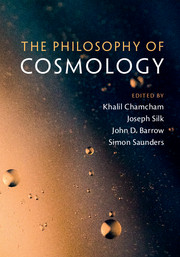Book contents
- Frontmatter
- Contents
- List of Contributors
- Preface
- Acknowledgments
- Part I Issues in the Philosophy of Cosmology
- Part II Structures in the Universe and the Structure of Modern Cosmology
- 5 Some Generalities About Generality
- 6 Emergent Structures of Effective Field Theories
- 7 Cosmological Structure Formation
- 8 Formation of Galaxies
- Part III Foundations of Cosmology: Gravity and the Quantum
- Part IV Quantum Foundations and Quantum Gravity
- Part V Methodological and Philosophical Issues
- Index
- References
5 - Some Generalities About Generality
from Part II - Structures in the Universe and the Structure of Modern Cosmology
Published online by Cambridge University Press: 18 April 2017
- Frontmatter
- Contents
- List of Contributors
- Preface
- Acknowledgments
- Part I Issues in the Philosophy of Cosmology
- Part II Structures in the Universe and the Structure of Modern Cosmology
- 5 Some Generalities About Generality
- 6 Emergent Structures of Effective Field Theories
- 7 Cosmological Structure Formation
- 8 Formation of Galaxies
- Part III Foundations of Cosmology: Gravity and the Quantum
- Part IV Quantum Foundations and Quantum Gravity
- Part V Methodological and Philosophical Issues
- Index
- References
Summary
Introduction
The equations of general relativity and its extensions are mathematically complicated and their general coordinate covariance offers special challenges to anyone seeking exact solutions or conducting numerical simulations. They are non-linear in a self-interacting (non-Abelian) way because the mediator of the gravitational interaction (the graviton) also feels the gravitational force. By contrast in an Abelian theory, like electromagnetism, the photon does not possess the electric charge that it mediates. As a result of this formidable complexity and non-linearity, the known exact solutions of general relativity have always possessed special properties. High symmetry, or some other simplifying mathematical property, is required if Einstein's equations are to be solved exactly. General solutions are out of reach.
This ‘generality’ problem has been a recurrent one in relativistic cosmology from the outset in 1916 when Einstein [1] first proposed a static spatially homogeneous and isotropic cosmological model with non-Euclidean spatial geometry in which gravitationally attractive matter is counter-balanced by a positive cosmological constant. This solution turned out to be unstable [2–6]. Subsequently, the appearance of an apparent ‘beginning’ and ‘end’ to simple expanding-universe solutions led to a long debate over whether these features were also unstable artefacts of high symmetry or special choices of matter in the known cosmological solutions, as Einstein thought possible. The quest to decide this issue culminated in a new definition of such ‘singularities’ which allowed precise theorems to be proved without the use of special symmetry assumptions. In fact, by using the geodesic equations, their proofs made no use of the Einstein equations [7, 8]. Special solutions of Einstein's equations, like the famous Gödel metric [9] with its closed timelike curves, also provoked a series of technical studies of whether its time-travelling paths are a general feature of solutions to Einstein's equations, or just isolated unstable examples. In the period 1967–1980 there was considerable interest in determining whether the observed isotropy of the microwave background radiation could be explained because it appeared to be an unstable property of expanding universes [10, 11].
- Type
- Chapter
- Information
- The Philosophy of Cosmology , pp. 85 - 108Publisher: Cambridge University PressPrint publication year: 2017



